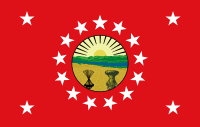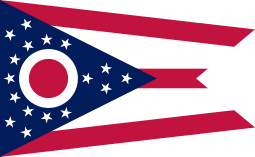Duncan McArthur
| Duncan McArthur | |
|---|---|
 | |
| 11th Governor of Ohio | |
|
In office December 18, 1830 – December 7, 1832 | |
| Preceded by | Allen Trimble |
| Succeeded by | Robert Lucas |
| Member of the U.S. House of Representatives from Ohio's 6th district | |
|
In office March 4, 1823 – March 3, 1825 | |
| Preceded by | John Sloane |
| Succeeded by | John Thomson |
| Member of the Ohio Senate from Ross, Franklin and Highland counties | |
|
In office 1805-1813 1821-1823 | |
| Preceded by |
Abraham Claypool Joseph Kerr |
| Succeeded by |
William Creighton, Sr. James Dunlap (1805-1813) David Crouse (1821-1823) |
| Member of the Ohio House of Representatives from Ross and Franklin counties | |
|
In office 1804-1805 1815-1816 1817-1818 | |
| Personal details | |
| Born |
June 14, 1772 Dutchess County, New York |
| Died |
April 29, 1839 (aged 66) Fruit Hill, Chillicothe, Ohio |
| Resting place | Grandview Cemetery |
| Political party | |
| Signature |
|
| Military service | |
| Allegiance |
|
| Service/branch |
|
| Years of service | 1812 - 1815 |
| Rank | Brigadier general |
| Commands | Army of the Northwest |
| Battles/wars | War of 1812 |
Duncan McArthur (June 14, 1772 – April 29, 1839) was a military officer and a Federalist and National Republican politician from Ohio. He served as the 11th Governor of Ohio.
When first elected to state office as a representative, he was serving in the state militia during the War of 1812. He was later appointed as Brigadier General in the U.S. Army and commanded a brigade under General William H. Harrison during the battle of the Thames. Shortly thereafter he was placed in charge of the Army of the Northwest, serving through 1817 and negotiating the Treaty of Fort Meigs of 1817 to ratify peace and land cessions with Native American tribes.
Biography
Born to Scottish immigrants in Dutchess County, New York,[1] McArthur grew up in western Pennsylvania and later moved to Kentucky, where he was employed as an Indian ranger.[2]
McArthur obtained a position with Nathaniel Massie in 1793, and worked with Massie on a surveying expedition in the Northwest Territory. In 1796, he worked with Massie to lay out the new town of Chillicothe, Ohio,[2] which was to become the state capital in 1803. McArthur moved across the Ohio River in 1797 to Chillicothe, where he gained wealth by his land speculations in the Northwest Territory.
Career
McArthur was elected to the United States House of Representatives from Ohio's 3rd congressional district while serving in the state militia during the War of 1812. He never qualified for office as he preferred to continue serving in the military.
He was appointed colonel of Ohio volunteers and was second-in-command to General William Hull at Fort Detroit. He and Colonel Lewis Cass were not present at Detroit when Hull surrendered and were greatly angered to hear that Hull had included both of them in the capitulation. When a British officer notified him of the surrender, McArthur is said to have torn off his epaulettes and broke his sword in a fit of rage, although historians note similar stories were told about other officers as well.[3] The British paroled him and McArthur returned to Ohio.
He was appointed a Brigadier General in the U.S. Army and commanded a brigade under General William H. Harrison during the battle of the Thames. Shortly thereafter he was placed in charge of the Army of the Northwest following Harrison's resignation.[4]
McArthur did not face much action after that, but he was engaged in negotiating treaties with the Indians. In 1817, he was one of two commissioners (along with Lewis Cass) who negotiated the Treaty of Fort Meigs, which was signed September 29 of that year with several Native American tribes.
McArthur served intermittently thereafter in the Ohio House of Representatives and Ohio State Senate. He was elected and served a single term from 1823-1825 in the United States House of Representatives before winning election to the governorship in 1830. McArthur served a single term and did not seek re-election.
Death
McArthur was buried in Grandview Cemetery, Chillicothe, Ross County, Ohio, USA.[5][6] The trust established in his will later became the subject of litigation that went before the U.S. Supreme Court in McArthur v. Scott.
Legacy
The small village of McArthur, Ohio, the seat of Vinton County, is named for him.
McArthur founded the city of Greenfield in 1799. Greenfield is located at N39 21.11958 W83 22.96284 (GPS coordinates), about 21 miles due west of Chillicothe. State Route 28, which runs between Greenfield and Chillicothe, in 1973 was named as General Duncan McArthur Highway per act of the 113th Ohio General Assembly.
References
- ↑ "Ohio Governor Duncan McArthur". National Governors Association. Retrieved July 27, 2012.
- 1 2 "Duncan McArthur". Ohio History Central. Retrieved July 28, 2012.
- ↑ Cramer 1937, p. 134
- ↑ Cramer 1937, p. 140
- ↑ "Duncan McArthur". Find A Grave. Retrieved July 27, 2012.
- ↑ "Grandview Cemetery". Grandview Cemetery. Retrieved August 5, 2012.
External links
| Wikimedia Commons has media related to Duncan McArthur. |
- National Governors Association
- Duncan McArthur at Ohio History Central
- Cramer, C. H. (April 1937). "Duncan McArthur: The Military Phase". Ohio Archaeological and Historical Quarterly. Ohio Historical Society. 46 (2): 128–147
- United States Congress. "Duncan McArthur (id: M000299)". Biographical Directory of the United States Congress.
![]() "McArthur, Duncan". Appletons' Cyclopædia of American Biography. 1900.
"McArthur, Duncan". Appletons' Cyclopædia of American Biography. 1900.
| Offices and distinctions | |||||||||||||||||||||||||||||||||||||||||||||||
|---|---|---|---|---|---|---|---|---|---|---|---|---|---|---|---|---|---|---|---|---|---|---|---|---|---|---|---|---|---|---|---|---|---|---|---|---|---|---|---|---|---|---|---|---|---|---|---|
| |||||||||||||||||||||||||||||||||||||||||||||||


